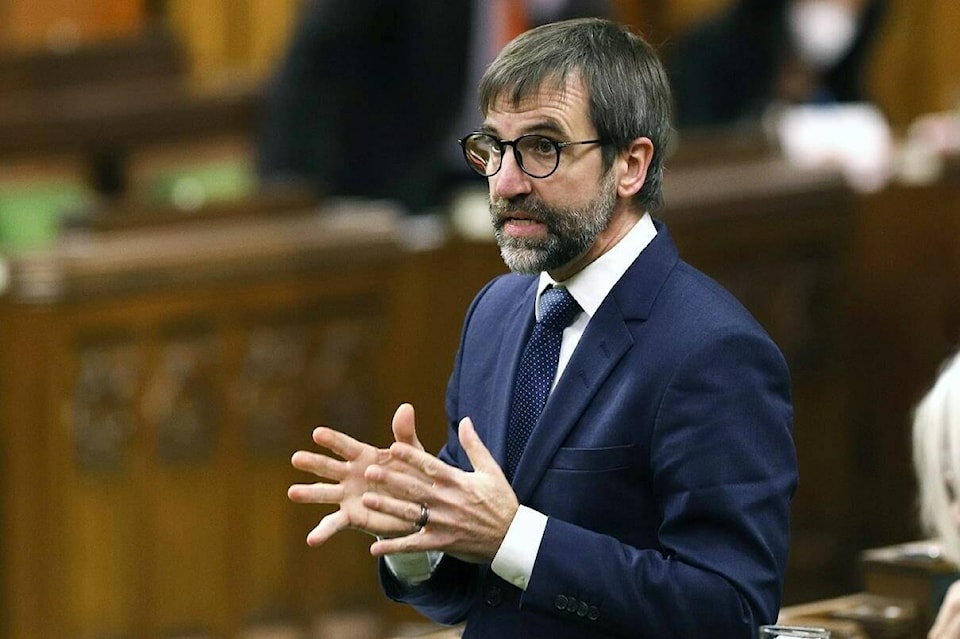Prime Minister Justin Trudeau told the Canadian oil industry Tuesday that it should use the massive bump in profits from the current surge in prices to fund a transition to cut their emissions.
The federal government unveiled its new emissions-reduction plan to reach its new greenhouse-gas targets by 2030. It projects the oil and gas industry needs to cut emissions 42 per cent from current levels if Canada is to meet its new goals.
Speaking at the Globe Forum sustainability conference in Vancouver, Trudeau said it is a “clear, reasonable contribution” for the sector to make and that the money is there for it to be done.
“With record profits, this is the moment for the oil and gas sector to invest in the sustainable future that will be good for business, good for communities, and good for our future,” Trudeau said.
“Big oil lobbyists have had their time on the field. Now, it’s over to the workers and engineers who will build solutions.”
The emissions plan, which was tabled in the House of Commons Tuesday, is a legislated requirement under the net-zero emissions law the government passed last year. Repeated reviews and updates are required as Canada moves toward the 2030 target deadline.
The plan uses economic and emissions modelling to gauge the most affordable and feasible projects when it comes to Canada’s target to cut emissions by 2030 to no more than 60 per cent of what they were in 2005.
The most recent emissions inventory is from 2019. It shows that Canada produced 730 million tonnes of carbon dioxide, or its equivalent in other greenhouse gases such as methane and nitrous oxide.
Canada needs to get to between 407 million tonnes and 443 million tonnes to hit the current target.
The oil and gas sector makes up the biggest share of Canada’s carbon footprint, with 26 per cent of total emissions. Oil and gas emissions are up 20 per cent since 2005.
The report projects that emissions from the oil and gas sector — including production, refining, and transportation via pipelines — could be 110 million tonnes by 2030, down from 191 million tonnes in 2019.
“We’re laying down a clear, reasonable contribution for the sector to make, so we can drive work forward on our commitment to cap and cut emissions,” said Trudeau.
“If there’s any oil and gas sector in the world that can do it, it’s Canada’s. If there’s any workforce in the world that can drive this shift, it’s Canadians.”
Environment Minister Steven Guilbeault insists this is not the cap on oil and gas emissions the Liberals promised as part of the fall election platform. The government is currently consulting on that, but he says the analysis used in this plan will inform how that cap is set.
The oil and gas projection is not good enough for several environment organizations, which say Canada’s overall target is still not ambitious enough and that within that target the oil and gas sector isn’t pulling its weight.
If the sector cut its emissions to 40 to 45 per cent of what they were in 2005, their target would be 88 to 96 million tonnes, not 110, or 50 to 53 per cent below current emissions.
“Tackling climate change must be a team effort, but the plan released today shows that some players are still sitting on the bench,” said Caroline Brouillette, national policy manager at the Climate Action Network — Canada.
Atiya Jaffar, Canada digital manager with 350.org, said the plan doesn’t keep up with the science and the fossil-fuel target is “appallingly low and nowhere close to the fossil fuel industry’s fair share.”
The plan includes $9 billion in new spending mostly to expand existing climate action grant and loan programs, including another $1.7 billion for electric vehicle rebates. More details on the new spending is expected in the next federal budget when it is tabled later this spring.
The plan also promises a tougher schedule to shift Canadian vehicle sales to electric models, mandating one in five new passenger vehicles be battery-operated by 2026, 60 per cent by 2030 and 100 per cent by 2035.
The current target set just last May says half of all new vehicles sold must be electric by 2030, and 100 per cent 2035.
Guilbeault said it will take a little longer for transport to catch up to other sectors on cutting emissions. Transportation accounts for one-quarter of all emissions, and its carbon footprint has increased 16 per cent in the last 17 years.
The report says by 2030 the sector should be able to cut emissions 23 per cent from current levels.
“We are making some progress between now and 2030,” Guilbeault said. “But there’ll be even more progress to come between 2030 and 2035.”
The government will also aim for one-third of medium- and heavy-duty vehicles sold to be electric by 2030 and 100 per cent by 2040.
The report forecasts that emissions from waste, including landfills, can be cut by 43 per cent by 2030, electricity by 77 per cent, heavy industry by 32 per cent, and emissions from buildings by 42 per cent.
—Mia Rabson, The Canadian Press
RELATED: Alberta government, Opposition say the province should be consulted on emissions caps
